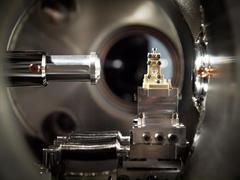URL: https://www.desy.de/news/news_search/index_eng.html
Breadcrumb Navigation
DESY News: World record: Plasma accelerator operates right around the clock
News
News from the DESY research centre
World record: Plasma accelerator operates right around the clock
A team of researchers at DESY has reached an important milestone on the road to the particle accelerator of the future. For the first time, a so-called laser plasma accelerator has run for more than a day while continuously producing electron beams. The LUX beamline, jointly developed and operated by DESY and the University of Hamburg, achieved a run time of 30 hours. “This brings us a big step closer to the steady operation of this innovative particle accelerator technology,” says DESY’s Andreas R. Maier, the leader of the group. The scientists are reporting on their record in the journal Physical Review X. “The time is ripe to move laser plasma acceleration from the laboratory to practical applications,” adds the director of DESY’s Accelerator Division, Wim Leemans.

In laser-plasma acceleration, a strong laser pulse (red) generates a plasma wave (blue) in hydrogen gas by stripping electrons from gas molecules. The electrons (red) ride the wave like a surfer in the wake of a boat. This pushes them to high energies extremely quick. The LUX facility has now continuously delivered more than 100 000 of these particle bunches in around 30 hours. Credit: DESY, Science Communication Lab
“The laser pulses plough their way through the gas in the form of narrow discs, stripping the electrons from the hydrogen molecules and sweeping them aside like a snow plough,” explains Maier, who is group leader at DESY's accelerator division and works at the Centre for Free-Electron Laser Science (CFEL), a joint enterprise between DESY, the University of Hamburg and the Max Planck Society. “Electrons in the wake of the pulse are accelerated by the positively charged plasma wave in front of them – much like a wakeboarder rides the wave behind the stern of a boat.”

Detailed simulation of the plasma wave in LUX. Credit: University of Hamburg, Laurids Jeppe
During the record-breaking nonstop operation, the physicists accelerated more than 100,000 electron bunches, one every second. Thanks to this large dataset, the properties of the accelerator, the laser and the bunches can be correlated and analysed much more precisely. “Unwanted variations in the electron beam can be traced back to specific points in the laser, for example, so that we now know exactly where we need to start in order to produce an even better particle beam,” says Maier. “This approach lays the foundations for an active stabilisation of the beams, such as is deployed on every high performance accelerator in the world,” explains Leemans.

The LUX plasma cell (in the centre of the white mounting), where the electrons are accelerated, is just a few millimetres long. Credit: University of Hamburg, Niels Delbos
“This work demonstrates that laser plasma accelerators can generate a reproducible and controllable output. This provides a concrete basis for developing this technology further, in order to build future accelerator-based light sources at DESY and elsewhere,” Leemans summarises.
Scientists from the University of Hamburg, the European ELI-Beamlines Project, the Max Planck Research School for Ultrafast Imaging & Structural Dynamics (IMPRS-UFAST) and DESY were all involved in the research.
Reference:
Decoding sources of energy variability in a laser-plasma accelerator; Andreas R. Maier, Niels M. Delbos, Timo Eichner, Lars Hübner, Sören Jalas, Laurids Jeppe,Spencer W. Jolly, Manuel Kirchen, Vincent Leroux, Philipp Messner, Matthias Schnepp, Maximilian Trunk, Paul A. Walker, Christian Werle, and Paul Winkler; Physical Review X, 2020; DOI: 10.1103/PhysRevX.10.031039



